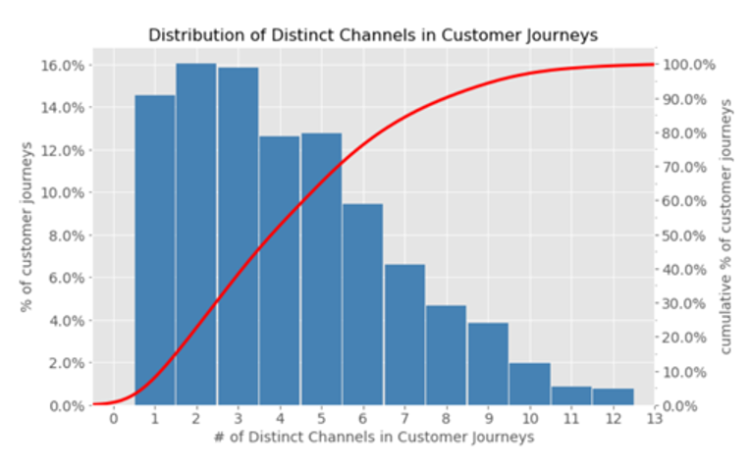
Understanding customer journeys in today’s multi-channel world is essential to successful marketing. It’s important to understand the contribution made by each step in each journey, as well as the human complexity involved.
First, let’s start with some actual data about customer journeys. At UniFida, we looked at the journey steps before a sale for an upmarket fashion retailer and found that in 2021 66,000 steps that could be linked to customers, both online and offline. These resulted in 25,000 sales, meaning an average of 2.64 events per sale.
In another direct-to-consumer customer journey data set, 244,000 steps preceded 96,000 sales in 2021, an average of 2.59 events per sale. On that basis, it appears that 2.6 steps is the average in terms of customer decision making.
Number of channels
Then there is the question of the number of channels that are involved in these journeys. Research by our partner Haensel AMS in Berlin (see graph below) revealed that, as well as 2.6 being the average number of steps, customers are most likely to use 2-3 different channels to arrive at a purchase.

Haensel AMS also looked at the length of time customers normally take from the start of their journey to the purchase. Nearly 40 per cent purchase in one week or less, while the remaining 60 per cent take between 2 and 20 weeks. This suggests two very different kinds of decision making are at play.
Looking at individual customer journeys, there seems to be no consensus on the right path to take. Each of the two example journeys shown below used different channels, but one has five steps and the other three, with one taking 28 days and the other 47. We could illustrate thousands of different journeys and you would be hard-pressed to find many with similar patterns.


Marketing effectiveness
So how do we turn this rich variety of journey steps into reliable evidence of the effectiveness of marketing activities?
One consideration is that marketers only pay for a proportion of all the customer journey steps, and of these, nothing for Direct Entry (although you could argue that Direct Entry is an indication of the strength of the brand and the customer’s relationship with it, which may historically have cost money to achieve).
Search engine events do not have a direct cost like a campaign, but they are more likely to lead to a sale if search engine optimisation has been well tuned. However, this still leaves a considerable number of paid-for channels from which marketers would like to measure for ROMI (return on marketing investment). This is where we can introduce the methodology that we have developed to at least untangle the financial return from each activity, if not the psychology behind the customer’s selection.
Three-step approach
1. We start at the moment of the sale and build a data set of every online and offline step that preceded it in a 90-day window (it could be less, but many journeys take longer than four weeks).
2. Next, we use maths to attribute a proportionate significance to each event preceding a sale. This is where we introduce a methodology developed by Haensel AMS which is based primarily on the time intervals before and after each step, but also on the amount of engagement with a website each step takes. In addition, Haensel provides a score to show the contribution each step makes towards the initiation, holding or closing of a sale.
3. In addition, we can drill down and compare how new and existing customers are performing, or men compared with women. We can start to answer questions such as: does social media X interest our high value customers? Or what is attracting customers to buy certain types of merchandise?
Impact on ROMI
So far so good, but we don’t yet know what the effect will be of pulling budget from certain campaigns or channels or increasing it. However, we can roll back in time with this attribution approach and look at earlier periods where spend was higher or lower in certain areas to see how this impacted ROMI.
To summarise, we have succeeded in developing a proven methodology for untangling the monetary impact of direct marketing activities. This can be very valuable when it comes to managing budgets or understanding what works and what doesn’t for specific groups of customers.
For more information visit www.unifida.co.uk








Share